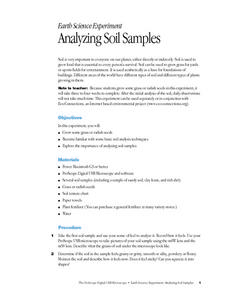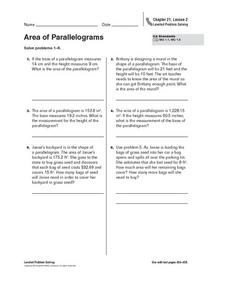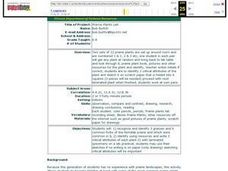Curated OER
The Grass is Always Greener
Third graders experiment with common grass and cellular division.
Curated OER
Land Use Issues
Students examine living and non-living things in their environment. They identify trees, plants, and grasses in their neighborhood and those that originate in Illinois in this unit of lessons.
Curated OER
Using the Land
In this land worksheet, high schoolers review the different ways that land is used such as landfills, topsoil, farmland, and hazardous waste. This worksheet has 13 true or false questions and 1 short answer question.
Curated OER
Prairie Find Outdoors
Students take a field trip to a local prairie. Using identification books, they identify various forbs and grasses in the prairie. As a class, they discuss the importance of forbs and grasses to the ecosystem and review the various types...
Curated OER
Poisoning the Prairie
Seventh graders investigate what pesticides are and why people use them. They examine the effect of pesticides on prairie grasses and what alternatives can be used.
Curated OER
Analyzing Soil Samples
Young scholars grow grass or radish seeds in this experiment, which takes three to four weeks to complete. They become familiar with basic soil analysis techniques, as well as, explore the importance of analyzing soil samples.
Curated OER
Area of Parallelograms - Lesson 2
Use this area of parallelograms practice worksheet to have learner ssharpen their problem solving skills as they solve six story problems.
Curated OER
Complexity Madness
After introducing the concept and formula for finding the area of a square, try this lesson plan. Fifth graders will use their prior knowledge to break apart various shapes in order to determine area. This lesson plan includes several...
Curated OER
Corn Harvest
Students read Corn Belt Harvest and write sentences about corn's uses. They visit a cornfield and a grain elevator or have guest speakers come to class. They design posters about harvesting or processing corn into grain.
Curated OER
Prairie Senses
Second graders use their senses to explore a prairie or imaginary prairie. They draw pictures to represent the five senses and discover how an artist describes non-visual sensations in a visual way.
Curated OER
Prairie Plants Lab
Students recognize and identify 3 grasses and 9 common forbs of the fermilab prairie and which were common in IL, identify using resources and write 3 critical attributes of each plant.
Curated OER
Creative Writing: Haiku
Haikus by Basho, Buson, Issa, and Shiki are used as models for a brief lecture on the importance of poetry in Japan's history and the structure of this poetic form. Students then go on a nature walk, record impressions, and return to the...
Curated OER
Composting
Using 2-liter bottles, junior ecologists create composting tubes in which they place nitrogen-rich and carbon-rich materials. They observe what changes occur over two weeks' time. Provide more specific direction to your class as to what...
Curated OER
Home Sweet Home
Students explore marine turtle habitats. Students research one species of marine turtle found in the Gulf of Mexico. They identify plants and animals in the habitat. They create a model or replica using information gathered through their...
Curated OER
Beautiful Bovine
Looking for a fun and interactive way to explore bovine biology? Learners read a brief informational text (included for printing) before participating in several cross-curricular activities. First, grab their attention with a hilarious...
Curated OER
Prairie Scavenger Hunt
Here is a simple lesson for young learners on the plants, animals, and flowers found in the prairie environment. There are worksheets embedded in the plan that pupils use once a teacher-led discussion and demonstration has taken place....
Curated OER
Discussing Poetry In Class
Students investigate syllabic metre and rhyming techniques by analyzing poetry. In this language arts lesson plan, students read the poem Considering the Snail and discuss the nature and mood of the poem with their classmates....
Curated OER
Stella the Swan
Students study the similarities and differences between ducks, geese, and swans. They tell the story about how water fowl adapt to life in water using props.
Curated OER
Fall Cubism Collage
Fall is an amazing season and leaves are fantastic subjects for artists to examine. Young artists use leaves to create fall collages using the rubbing technique.
Curated OER
How Are Plants Similar And Different?
Studetns create an index card database of different categories of plants such as bushes, trees, flowers, grasses and vegetables. They review the different parts of a plant and label pictures of plants on the database cards. They use the...
Curated OER
Study in Line Direction
Students study line direction in art. In this art activity on lines, students look at art that portrays lines being used in different ways. They will use what they have learned about lines to create a final composition depicting either...
Curated OER
Paper Molas
Delve into the history of textile art using this resource. Learners discuss the history of molas, a type of textile art made in Panama and Columbia, and talk about the importance of this process in the Kuna culture. Then, they create...
Curated OER
Basic Needs of Living Things - Lesson Two
Fourth graders study and identify the basic needs of a variety of organisms. Terrariums and aquariums are used to demonstrate what plants, animals, and fish need to stay alive. These two classic models are used to effectively convey what...























